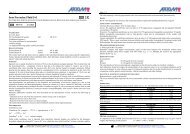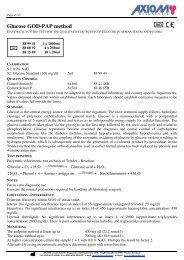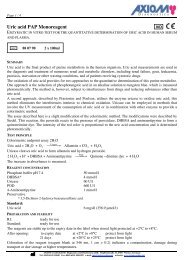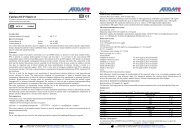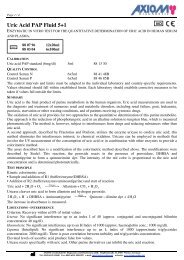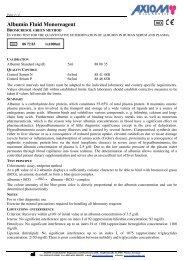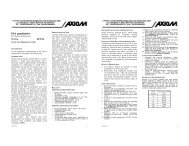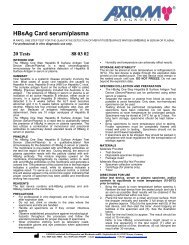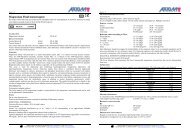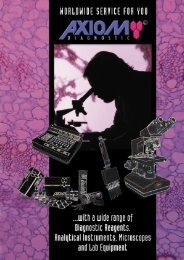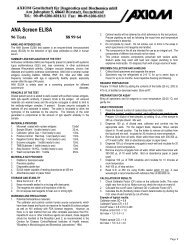GPT ALAT 88 36 15 - AXIOM Solutions
GPT ALAT 88 36 15 - AXIOM Solutions
GPT ALAT 88 36 15 - AXIOM Solutions
Create successful ePaper yourself
Turn your PDF publications into a flip-book with our unique Google optimized e-Paper software.
Page 3 / 4<br />
D I A G N O S T I C<br />
SPECIMEN<br />
Collect serum using standard sampling tubes.<br />
Heparin or EDTA plasma.<br />
Stability: 24 hours at +20°C to +25°C<br />
3 days at +2°C to +8°C<br />
Separate serum/plasma from clot/cells within 8 hours at room temperature or 48 hours at +2°C to +8°C.<br />
Centrifuge samples containing precipitate before performing the assay<br />
TESTING PROCEDURE<br />
Materials provided<br />
• Working solutions as described above<br />
Additional materials required<br />
• Controls as indicated below<br />
• 0.9% NaCl<br />
Manual procedure serum start:<br />
Wavelength<br />
Hg 334 nm, 340 nm or Hg <strong>36</strong>5 nm<br />
Temperature<br />
+25°C / +30°C / +37°C<br />
Cuvette<br />
1cm light path<br />
Zero adjustment<br />
against air<br />
Mix R1 and R2 5+1. This solution is stable: up to 10 days at +2°C to +8°C or<br />
up to 1 day at +20°C to +25°C<br />
Reagent mixture 1000 µl<br />
Serum / plasma 100 µl<br />
Mix and incubate 60 seconds at assay temperature and start stopwatch simultaneously. Read again after exactly<br />
1, 2 and 3 minutes.<br />
Calculation:<br />
Hg <strong>36</strong>5 nm<br />
Hg 340 nm<br />
Hg 334 nm<br />
3235 x !A/min<br />
1746 x !A/min<br />
1780 x !A/min<br />
Manual procedure substrat start:<br />
Wavelength<br />
Hg 334 nm, 340 nm or Hg <strong>36</strong>5 nm<br />
Temperature<br />
+25°C / +30°C / +37°C<br />
Cuvette<br />
1cm light path<br />
Zero adjustment<br />
against air<br />
R 1 1000 µl<br />
Serum / plasma 100 µl<br />
Mix and incubate 60 seconds at assay temperature then add<br />
R2 200 µl<br />
Mix, read initial absorbance and start stopwatch simultaneously. Repeat reading after exactly 1, 2 and 3 min.<br />
Calculation:<br />
Hg <strong>36</strong>5 nm<br />
Hg 340 nm<br />
Hg 334 nm<br />
CALIBRATION FREQUENCY<br />
Two point calibration is recommended<br />
• after reagent lot change<br />
• as required following quality control procedures<br />
Calibration verification: Not necessary<br />
3823 x !A/min<br />
2063 x !A/min<br />
2103 x !A/min<br />
Page 4 / 4<br />
DISPOSAL<br />
Please note the legal regulations.<br />
D I A G N O S T I C<br />
LITERATURE<br />
1. Bablok W et al. A General Regression Procedure for Method Transformation. J Clin Chem Clin Biochem 19<strong>88</strong>; 26:783-790.<br />
2. Berg Meyer HU, Herder M, Red R. Approved recommendation (1985) on IFCC methods for the measurement of catalytic<br />
concentration of enzymes. Part 3. (FCC Method for alanine aminotransferase. J Clin Chem Clin Biochem 1986; 24:481-489.<br />
3. Glick MR, Ryder KW, Jackson SA. Graphical Comparisons of Interferences in Clinical Chemistry Instrumentation.<br />
Clin Chem 1986;32:470-474.<br />
4. Greiling H, Gressner AM (Hrsg.). Lehrbuch der Klinischen Chemie und Pathobiochemie, 3rd Stuttgart/New York:<br />
Schattauer Verlag, 1995.<br />
5. Passing H, Bablok W. A New Biometrical Procedure for Testing the Equality of Measurements from Two Different Analytical<br />
Methods. J Clin Chem Clin Biochem 1983;21 :709-720.<br />
6. Thefeld W et al. Dtsch med Wschr 1974;99:343.<br />
7. Tietz NW (Hrsg.). Clinical Guide to Laboratory Tests, 3rd Philadelphia, Pa: WB Saunders, 1995:20-21.<br />
8. Wallnöfer H, Schmidt E, Schmidt FW (Hrsg.). Synopsis der Leber- krankheiten. Stuttgart: Georg Thieme Verlag, 1974.<br />
9. Wroblewski F LaDue JS. Ann Intern Med 1956;45:801.<br />
10. Wroblewski F, LaDue JS. Proc Soc Exp Biol Med 1956;91 :569.<br />
<strong>AXIOM</strong> Product range Clinical Chemistry<br />
Enzymes Ions Other Metabolites<br />
Acid Phosphatase Ammonium fluid Bilirubin T/D<br />
Alkaline Phosphatase Copper fluid Creatinine fluid<br />
!-Amylase direct Calcium fluid Glucose GOD-PAP fluid<br />
CK-NAC actived Chloride fluid Glucose Hexokinase fluid<br />
CK-MB (NAC- actived) Inorganic Phosphorus UV fluid Urea Enzymatic fluid<br />
"-GT fluid Iron fluid Urea UV fluid<br />
LDH fluid TIBC Uric Acid PAP fluid<br />
Cholinesterase<br />
Magnesium fluid<br />
GOT/ASAT fluid<br />
Potassium fluid<br />
<strong>GPT</strong>/<strong>ALAT</strong> fluid<br />
Sodium fluid<br />
Controls<br />
Lipase UV fluid<br />
Control Serum N<br />
Lactate PAP<br />
Control Serum P<br />
Proteins<br />
!-HBDH<br />
Lipids<br />
Albumin<br />
CSF-Protein fluid<br />
Cholesterol fluid<br />
Microprotein fluid<br />
HDL Cholesterol<br />
Hemoglobin<br />
LDL Cholesterol<br />
Protein Total fluid<br />
Triglycerides fluid<br />
06/09 M/kd<br />
<strong>AXIOM</strong> Gesellschaft für Diagnostica und Biochemica mbH; Siegfriedstraße 14, 67547 Worms, Germany<br />
Tel.: 0049-6241-50040 Fax: 0049-6241-5004499 e-mail: info@axiom-online.net webseite: www.axiom-online.net<br />
<strong>AXIOM</strong> Gesellschaft für Diagnostica und Biochemica mbH; Siegfriedstraße 14, 67547 Worms, Germany<br />
Tel.: 0049-6241-50040 Fax: 0049-6241-5004499 e-mail: info@axiom-online.net webseite: www.axiom-online.net



